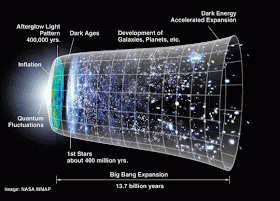Οι
ερευνητές χρησιμοποίησαν για τη μέτρηση ως... στόχους δεκάδες χιλιάδες κβάζαρ
(πυρήνες μακρινών αρχαίων γαλαξιών). An artist's conception of how BOSS
uses quasars to measure the distant universe. Light from distant quasars is
partly absorbed by intervening gas, which is imprinted with a subtle ring-like
pattern of known physical scale. Astronomers have now measured this scale with
an accuracy of two percent, precisely measuring how fast the universe was
expanding when it was just 3 billion years old. Credit: Illustration by Zosia
Rostomian, Lawrence Berkeley National Laboratory, and Andreu Font-Ribera, BOSS
Lyman-alpha team, Berkeley Lab.
Αμερικανικό
πρόγραμμα για τη χαρτογράφηση του ουρανού πραγματοποίησε μια μέτρηση για τη
διαστολή του Σύμπαντος η οποία, σύμφωνα με τους επιτελείς του προγράμματος,
είναι η ακριβέστερη που έχει γίνει μέχρι σήμερα.
Τρέξε
Σύμπαν, τρέξε
This drawing
illustrates how astronomers of the third Sloan Digital Sky Survey (SDSS-III)
used quasar light to trace the expansion of the universe. The expansion is
shown by the circular disks of increasing area from left to right. From the Big
Bang, the expansion occurs rapidly, then slows down, then speeds up again as
dark energy pushes apart walls and filaments of galaxies at different distances
(purple). As light travels to us from very distant quasars (white dots on the
left), it passes through the expanding universe, carrying with it the story of
its journey through this expanding cosmic web. Astronomers have measured the
expansion of the universe by tracing how quasar light has passed through these
structures. Image: Paul Hooper at Spirit Design, with Mat Pieri and Gongbo
Zhao, ICG
Έχει διαπιστωθεί ότι το Σύμπαν μετά τη γέννησή του πριν από περίπου 14 δισ. έτη
άρχισε να διαστέλλεται χωρίς αυτή η διαδικασία να σταματήσει ποτέ. Μάλιστα τα
τελευταία χρόνια όλα τα σχετικά ευρήματα δείχνουν ότι αυτή η διαστολή όχι μόνο
συνεχίζεται αλλά είναι και επιταχυνόμενη.
This graphic shows the universe as it evolved from the Big Bang to now. Nasa scientists believe that the universe expanded from subatomic scales to the astronomical in just a fraction of a second after its birth. Credit: NASA/WMAP
Η
νέα μελέτη του προγράμματος BOSS (Baryonic Oscillation Spectroscopic Survey)
εντόπισε στοιχεία που αποκαλύπτουν τη διαστολή του Σύμπαντος περίπου τρία δισ.
έτη μετά την γέννησή του. Διεθνής ομάδα ερευνητών με επικεφαλής επιστήμονες του
Εθνικού Εργαστηρίου Lawrence Berkeley στις ΗΠΑ μελέτησε τα νέα δεδομένα και
κατέληξε στο συμπέρασμα ότι πριν από δέκα δισ. έτη το Σύμπαν είχε μπει σε μια
φάση διαστολής η οποία οδηγούσε σε επέκταση του κατά 1% κάθε 44 εκ. έτη.
Cosmic Microwave
Background radiation, or CMB for short, is a faint glow of light that fills the
universe. Pictured is the microwave radiation from the whole sky, captured by
the European Space Agency's Planck satellite.
Οι
ερευνητές έκαναν τη «χρονομέτρηση» μελετώντας λεπτομερείς χάρτες της κατανομής
της ύλης του Σύμπαντος. Θα πρέπει να σημειωθεί ότι αν τα αποτελέσματα αυτά
είναι ορθά, τότε η διαστολή του Σύμπαντος ήταν εκείνη την εποχή ελαφρώς πιο...
αργή από εκείνη που προτείνει το καθιερωμένο μοντέλο Κοσμολογίας.




Δεν υπάρχουν σχόλια:
Δημοσίευση σχολίου